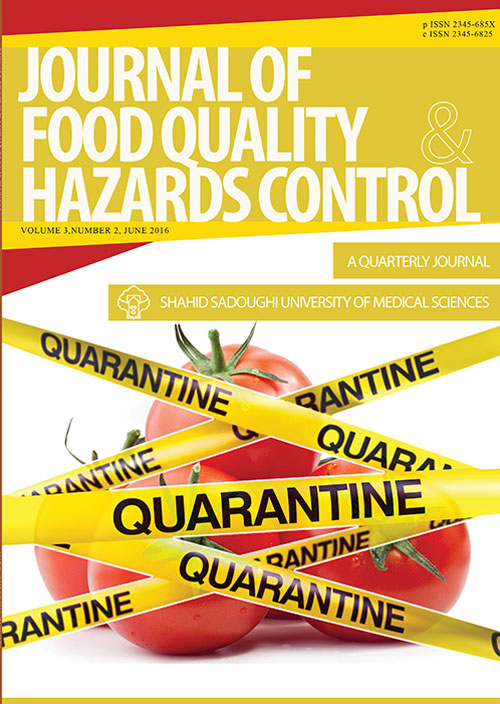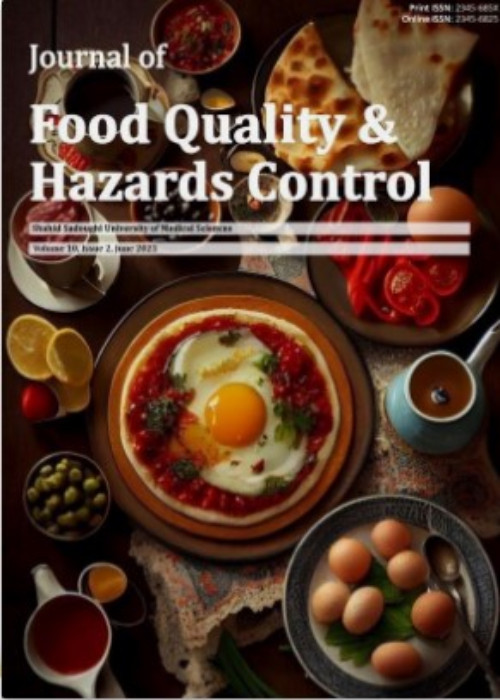فهرست مطالب

Journal of Food Quality and Hazards Control
Volume:3 Issue: 2, Jun 2016
- تاریخ انتشار: 1395/05/05
- تعداد عناوین: 8
-
-
Pages 41-47BackgroundDeoxynivalenol (DON) is a mycotoxin produced mainly by Fusarium graminearum in grains such as wheat and maize. The aim of this study was to evaluate the inhibitory effects of citrus flavanones including, naringin (NAR), hesperidin (HES), and neohesperidin (NEO) on deoxynivalenol production using Response Surface Methodology (RSM).MethodsThe studied flavanones were extracted from residues of citric industries and assayed in rice media inoculated with F. graminearum. After Gas Chromatography (GC) analysis, RSM was applied to find the optimal flavanones concentrations that would lead to total inhibition of DON production. The four levels studied were 0, 0.11, 0.21, and 0.42 mmol/kg rice in dry basis, for each flavanone. Statistical analysis was performed using the statgraphics centurion XV package, version 15.2.6 (StatPoint Technologies, USA). Experimental design consisted in ten factorial points was evaluated in triplicate and used in the model.ResultsAll flavanones and their mixtures significantly decreased the accumulation of DON in rice media respect to control (pConclusionUsing RSM, the citric flavanones studied in this work, was proved to be effective for total inhibition of DON accumulation.Keywords: Flavanones, Fusarium, Deoxynivalenol, Prevention, Control
-
Pages 48-52BackgroundMahyaveh is an Iranian salted-fermented fish sauce which due to its high amount of protein has risk of histamine production. This study was carried out to determine effect of Zataria multiflora Essential Oil (EO) on histamine production in mahyaveh.MethodsDried anchovies (Stolephorus sp.), refined-salt and mustard seed (Brassica juncea) were purchased from the local market in Bandar Abbas, Iran. Three concentrations of EO including 0.1, 1, and 2% v/w were prepared by hydro-distillation of the air-dried powdered of Z. multiflora plant for 3 h, using British-type Clevenger apparatus. Histamine was determined by Enzyme Linked Immunosorbent Assay (ELISA). Mean values of histamine were compared using SPSS, Inc, Chicago, IL software (v. 16.0).ResultsMost of the samples showed increasing in the level of histamine when storage time was increased. At day 30, histamine level in all treatment samples containing 0.1, 1, and 2% of Z. multiflora EO were significantly lower than control group (p0.05) with control ones except 0.1% EO group. Analysis of four sensory items including color, odor, taste, and overall acceptance indicated that there was no significant difference between mean score of control and treatment groups. Overall acceptance scores in 0, 0.1, 1, and 2% EO were 6.33, 5, 6.33, and 5, respectively.ConclusionZ. multiflora EO could effectively serve as potential antimicrobial agent to inhibit histamine production in mahyaveh.Keywords: Fish Products, Fermentation, Histamine, Plants, Oils Volatile
-
Pages 53-59BackgroundClassical bacteriological detection of Brucella species from food, and environment is routinely carried out based on morphological and biochemical characteristics. However, for increasing specificity and sensitivity of species identification methods, development of a molecular assay is necessary that was main aim of this study.MethodsPanel of some reference strains belonging to the phylum Proteobacteria were specifically used in this study. Additionally, the panel was enriched with 20 Brucella field strains isolated from 13 cattle and 7 sheep (West Kazakhstan region), and six strains from three cattle and three sheep (Almaty region). Bacterial identification before designing was carried out based on 16S rRNA sequencing with universal primers. Primer design was implemented using the Primer3 program. Finally, specificity and sensitivity of the PCR assay for Brucella identification were evaluated.ResultsThe sensitivity of the developed conventional PCR assays was assessed with the range of 2×105 to 12 genomic copies isolated from B. abortus 100 and B. melitensis H-12 reference strains. The sensitivity of the developed assays using Ba and Ba-r, Bm and Bm-r primers was determined to be 1.6×103 genomic copies.ConclusionQuick detection and species identification of Brucella strains circulating in Kazakhstan would help local authorities in decision-making and implementation of the most effective strategies for control of these bacteria. Our PCR-based assay was the first step towards developing a novel kit with final aim of standardizing molecular identification of B. abortus and B. melitensis in foods of animal origin in Kazakhstan and other central Asia countries.Keywords: Polymerase Chain Reaction, Brucella, Food Safety
-
Pages 60-66BackgroundDue to high content of unsaturated fatty acids, trout is susceptible to oxidative spoilage. In this study, the effects of Thymus vulgaris Essential Oil (EO) and extract on oxidative stability of cooked rainbow trout fillet during four months frozen storage period were investigated.MethodsThree groups of fish fillets were treated with thyme EO and three other groups were treated with thyme extract and cooked by frying, oven, and steam. Fat hydrolysis was evaluated by measuring Free Fatty Acid (FFA) value and oxidation products were measured via Peroxide Value (PV) as well as Thiobarbituric Acid (TBA) value. Sensory analysis was evaluated by the overall acceptability using a 9-point hedonic scale. Statistical analyses were performed in SPSS, Inc, Chicago, IL software.ResultsMain components of T. vulgaris were thymol (60.54%), α-terpinen (9.47%), p-cymene (8.54%) and carvacrol (3.33%). The amount of FFA in oven baked samples (4.514.75% oleic acid) and steamed fillets (4.835.20% oleic acid) was significantly (p0.05).ConclusionBoth thyme EO and extract effectively retarded the oxidation during frozen storage. However, the samples treated with thyme extract showed slower formation of free fatty acid, hydroperoxide and malonaldehyde than those of EO-treated or control samples. It is recommended to apply thyme EO and extract in producing ready-to-eat fish products.Keywords: Antioxidants, Plant Extracts, Oils, Volatile, Food Preservation, Trout
-
Pages 67-72BackgroundDominant Lactic Acid Bacteria (LAB) originally isolated from traditional non-dairy fermented foods, may harbor unique characteristics such as probiotic properties. In this research, probiotic potential of dominant LAB isolated from pickled garlic was studied.MethodsAfter isolation of dominant LAB from pickled garlic produced with apple cider vinegar, the isolate was identified by Polymerase Chain Reaction (PCR). Probiotic properties of mentioned isolate including survival in simulated conditions of gastrointestinal tract; antibacterial effects against Escherichia coli, Staphylococcus aureus, Listeria monocytogenes and Salmonella enterica; ability of aggregation with these food-borne indicators; and finally antibiotic susceptibility of the isolate were investigated. Results were also analyzed statistically by SPSS software.ResultsSequencing results of PCR products identified Lactobacillus fermentum as dominant LAB in pickled garlic. L. fermentum had 36.30% and 66.08% survival in pH 2 and 0.3% bile salt after 3 and 4 h incubation, respectively. Inhibition zone diameter of L. monocytogenes and aggregation ability of the LAB isolate with L. monocytogenes was significantly (pConclusionL. fermentum isolated from pickled garlic had high potential for using as probiotic bacteria in food and medicinal applications.Keywords: Lactobacillus fermentum, Garlic, Probiotics, In Vitro Techniques
-
Pages 73-75BackgroundSalt content and pH degree are the quality indicators of bread which their unauthorized levels may have harmful effects on body health. Accordingly, this survey was carried out to evaluate pH and salt contents in bread samples produced in Mashhad, Iran.MethodsTotally 708 bread samples (340 loaves of Lavash, 183 loaves of Taftun, 139 loaves of Barbari and 46 loaves of Sangak bread samples) were provided randomly from different bakeries of Mashhad, Iran during 2015. Levels of pH and salt in baked bread were determined according to Iranian national standards. Data were analyzed using SPSS, Inc., Chicago, USA version16.0.ResultsAmong 708 samples, mean salt level in different bread samples was 1.22±0.09% which 0.1% samples contained higher salt content than acceptable limit of ≤1.8%. There were no significant differences between content of salt as well as pH among various types of bread (p>0.05). The lowest and highest salt concentration were found in Taftoon (1.21±0.08%) and Sangak (1.25±0.2%), respectively. Out of the total samples, 10.6% of them had pH≥6 which were higher than the standard limit. The mean level of pH in total samples was 5.51±0.45. Lavash (5.49±0.46) and Sangak (5.61±0.51) bread had the lowest and highest pH degree, respectively with no significant difference (p>0.05).ConclusionThis survey revealed that there were yet some local bakeries in Iran that produced different kinds of bread with unacceptable levels of salt and baking soda. So, it seems crucial for continual supervision and monitoring in the bakeries of this area as well as training bakers not to use unacceptable additives.Keywords: Food Quality, Sodium Chloride, Hydrogen, Ion Concentration, Bread, Iran
-
Page 76
-
Page 77


